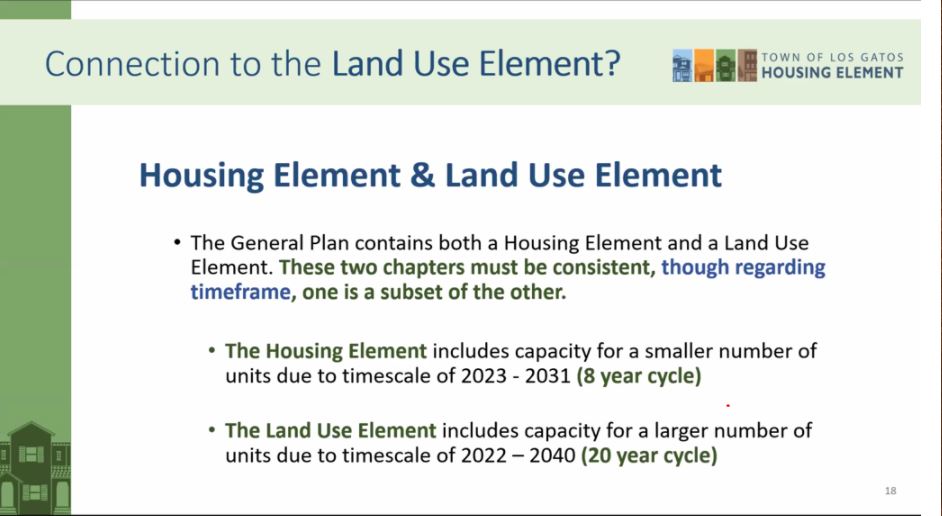 At the most recent Housing Element Advisory Committee meeting, the consultants presented this slide which states that the dwelling unit capacity for the Housing Element (1,993) was smaller in number than the capacity for the Land Use Element (3,738) “due to timescale” differences. The implication was that since the Housing Element must be amended by state law every 8 years while the draft 2040 General Plan employs a 20-year planning horizon, the “capacities” for the elements are different solely because of different planning horizons (8 years vs. 20 years).
At the most recent Housing Element Advisory Committee meeting, the consultants presented this slide which states that the dwelling unit capacity for the Housing Element (1,993) was smaller in number than the capacity for the Land Use Element (3,738) “due to timescale” differences. The implication was that since the Housing Element must be amended by state law every 8 years while the draft 2040 General Plan employs a 20-year planning horizon, the “capacities” for the elements are different solely because of different planning horizons (8 years vs. 20 years).
But is the difference in “capacities” due to different timescales? We think not, and here’s why.
First, we need to explain one of the central purposes of the Housing Element in the General Plan. Among other requirements, the Housing Element must include an inventory of land suitable and available for residential development to meet the Town’s RHNA allocation by income level. Scarcity of land with adequately zoned capacity is a significant contributor to increased land prices and housing development costs. The Housing Element establishes The Towns’ strategy to plan for and facilitate the development of housing over an eight-year planning period by providing an inventory of available land adequately zoned or planned to be zoned for housing and programs to implement the strategy.
The purpose of the Housing Element’s site inventory is to identify and analyze specific sites that are suitable and available for residential development. The site inventory enables the Town to determine whether there are sufficient adequate sites to accommodate the RHNA allocation by income category. This will determine whether program actions must be adopted to make more sites available with appropriate zoning, development standards, and infrastructure capacity to accommodate the new development needed. The Government Code further requires a development capacity analysis of each site included in the Housing Element’s land inventory. The Town must determine the realistic number of housing units that can be developed for each site. In determining development capacity, the Town must consider factors such as realistic development capacity, typical densities of existing developments at a similar affordability level in the Town, and current and planned availability and accessibility of sufficient sewer, water and utilities.
Here is an example of how the actual development capacity calculation of a particular site can be computed:
|
Site size |
2.5 acres |
|
Zoning |
High Density Residential |
|
Allowable Density |
30 – 40 dwelling units per acre |
|
RHNA affordability |
Lower Income |
|
Existing Use |
Vacant |
| Maximum Allowable Capacity | 2.5 acres x 40 units = 100 units |
Capacity Adjustment Factors:
Land use control 95% – adjustment for net acreage due to on-site improvements
Typical densities 55% – adjustment based on past development trends for HDR
Realistic Capacity utilizing factors 100 x (.95) x (.55) x (.95) = 49 units
This example shows the difference between “capacity” as computed by the Housing Element (49 units) compared to the capacity computed under the Land Use Element (100 units). Simply put, Housing Element capacity does not change based on timescale. Timescale plays no factor in determining capacity. Rather the Housing Element capacity is the summation of the realistic development capacity of each site identified by the Housing Element land inventory. This is a number that does not change depending on timescale, and which in aggregate can then be determined to be sufficient or insufficient to accommodate the RHNA allocation by income level. The Housing Element capacity is calculated independently from the RHNA allocation, which is determined every 8 years. If the RHNA allocation changed, either increasing or decreasing in amount or timeframe (e.g., every 5 years), the Housing Element capacity would remain constant. Timeframe has no impact on determining capacity.
Let’s now quickly discuss the concept of housing capacity as used in the Land Use Element. The Land Use Element designates among other items, the proposed general distribution, location, and extent of land uses for housing, business, and industry and the extent of housing density and intensity.
As part of the Land Use Element, the Town is required to provide a development capacity or “build-out analysis” that represents an estimate of the total amount of housing capacity that may be built in an area under certain assumptions, including applicable land use laws and zoning policies and environmental constraints. Calculating the acreage within each land use category and multiplying that number by the applicable density and intensity factor provides a theoretical development capacity. The time horizon at which this theoretical development potential is achieved is not specified or anticipated by the General Plan. Development capacity is not a forecast and has no planning horizon. Rather the build-out analysis is a static measurement of maximum allowable development that could occur under the land use laws and zoning policies that are in place.
The theoretical land use capacity can only change if new land uses are created, or zoning densities are changed – not because of changes in timescale. Simply put, the Land Use Element’s development capacity measures the maximum allowable development capacity under the approved land uses and zoning densities in place as opposed to what could be developed over the General Plan’s planning horizon, whether that is 8 years, 10 years, or 20 years.

Leave a Reply